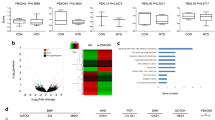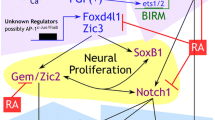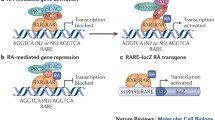Abstract
In a previous study we investigated the effects of RA excess on TGF β protein localization in early postimplantation stages of mouse development. Here we extend this investigation by comparing the effects of retinoid deficiency with those of excess, and by comparing the effects of altered retinoid status on TGF β protein and RNA transcript distribution. In vitamin A-deficient embryos, TGF β1 RNA and protein distribution were both unaltered compared with controls; conversely, TGF β2 protein levels were reduced while RNA levels remained normal. In RA-treated embryos, the previous study showed that intracellular TGF β1 levels were decreased, while those of extracellular TGF β1 were initially decreased but subsequently increased; here we found that TGF β1 RNA transcript levels were reduced following exposure to RA excess. TGF β2 showed a clear disparity between the effects of RA excess on protein and RNA transcript levels: RNA transcript distribution was unchanged or showed a slight increase in RA-treated embryos, whereas the previous results showed greatly reduced protein levels. The new results provide further evidence for interaction between retinoids and TGF βs during mouse development, and indicate that retinoids are capable of differentially regulating TGF β isoforms through mechanisms involving different stages in the process of TGF β synthesis and secretion. The long-term nature of the effects of transient exposure to RA excess suggests that the mechanisms of RA-TGF β interaction may be indirect.
Similar content being viewed by others
References
Barnard JA, Lyons RM, Moses HL (1990) The cell biology of transforming growth factor β. Biochim Biophys Acta 1032:79–87
Bernfield M, Banerjee SD, Koda JE, Raprareger AC (1984) Remodelling of the basement membrane as a mechanism of morphogenetic tissue interaction. Symp Soc Dev Biol 42:545–572
Chen D (1984) The vital importance of contraception. In: Retinoids: new trends in research therapy. Reports from the retinoid symposium, Geneva, pp 24–28
Coombes RC, Barrett-Lee P, Luqmani Y (1990) Growth factor expression in breast tissue. J Steroid Biochem Mol Biol 37:833–836
Derynck D, Jarrett JA, Chen EY, Goeddel DV (1985) The murine transforming growth factor β precursor. J Biol Chem 261:4377–4379
De Thé H, Mar V-R del, Tiollais P, Stunnenberg H, Dejean A (1990) Identification of a retinoic acid responsive element in the retinoic acid receptor β gene. Nature 343:177–180
Dickson M, Slager H, Duffie E, Mummery C, Akhurst R (1993) RNA and protein localization of TGF β2 in the early mouse embryo suggests an involvement in cardiac development. Development 117:625–639
Edwards DR, Murphy G, Reynolds JJ, Whitham SE, Docherty J, Angel P, Heath JK (1987) Transforming growth factor beta modulates the expression of collagenase and metalloproteinase inhibitor. EMBO J 6:1889–1904
Ellingsworth LR, Brennan JE, Fok K, Rosen DM, Bentz H, Piez KA, Seyedin SM (1986) Antibodies to the N-terminal portion of cartilage-inducing factor A and transforming growth factor β. J Biol Chem 261:12362–12367
Flanders KC, Roberts AB, Ling N, Fleurdelys BE, Sporn MB (1988) Antibodies to peptide determinants of transforming growth factor β and their applications. Biochemistry 27:739–746
Flanders KC, Thompson ML, Cissel DS, Van Obberghehn-Schilling E, Baker CC, Kass ME, Ellingsworth LR, Roberts AB, Sporn MB (1989) TGF β1: histochemical localization with antibodies to different epitopes. J Cell Biol 108:653–660
Flanders KC, Cissel DS, Mullen LT, Danielpour D, Sporn MB, Roberts AB (1990) Antibodies to transforming growth factor β2 peptides: specific detection of TGF β2 in immunoassays. Growth Factors 3:45–52
Fukiishi Y, Morriss-Kay GM (1992) Migration of cranial neural crest cells to the pharyngeal arches and heart in rat embryos. Cell Tissue Res 268:1–8
Glick AB, Flanders KC, Danielpour D, Yuspa SH, Sporn MB, Roberts AB (1989) Retinoic acid induces transforming growth factor-β2 in cultured keratinocytes and mouse epidermis. Cell Regul 1:87–97
Glick AB, McCune BK, Abdulkareem N, Flanders KC, Lumadue JA, Smith JM, Sporn MB (1991) Complex regulation of TGF β expression by retinoic acid in the vitamin A deficient rat. Development 111:1081–1086
Hale F (1933) Pigs born without eyeballs. J Hered 24:105–106
Hale F (1935) Relation of vitamin A to anophthalmos in pigs. Am J Opthalmol 18:1087–1093
Hale F (1937) Relation of maternal vitamin A to microphthalmia in pigs. Texas State Med 33:228–232
Heine UI, Munoz EF, Flanders KC, Ellingsworth LR, Lam H-YP, Thompson NL, Roberts AB, Sporn MB (1987) Role of transforming growth factor β in the development of the mouse embryo. J Cell Biol 105:2861–2876
Heine UI, Munoz EF, Flanders KC, Roberts AB, Sporn MB (1990) Colocalization of TGF-beta 1 and collagen I and II, fibronectin and glycosaminoglycans during lung morphogenesis. Development 109:29–36
Heino J, Ignotz RA, Hemler ME, Crouse C, Massague J (1989) Regulation of cell adhesion receptors by transforming growth factor β. J Biol Chem 264:380–388
Ignotz R, Massagué J (1986) TGF β stimulates the expression of fibronectin and collagen and their incorporation into the extracellular matrix. J Biol Chem 261:4337–4345
Kamn JJ (1982) Toxicology, carcinogenicity and teratogenicity of some orally administered retinoids. J Am Acad Dermatol 6:652–659
Kim S-J, Angel P, Lafyatis R, Hattori K, Kim K-Y, Sporn MB, Karin M, Roberts AB (1990) Autoinduction of TGF β1 is mediated by the AP-1 complex. Mol Cell Biol 10:1492–1497
Kojima S, Nara K, Rifkin D (1993) Requirement for transglutaminase in the activation of latent TGF β in bovine endothelial cells. J Cell Biol 121:439–448
Lammer EJ, Chen DT, Hoar RM, Agnish ND, Benke PJ, Braun JT, Curry CJ, Frenhoff PM, Grix AW, Lott IT, Richard JM, Sun SC (1985) Retinoic acid embryopathy. N Eng J Med 313:837–841
Lawler S, Candia AF, Ebner R, Shum L, Lopez AR, Moses HL, Derynck R (1994) The murine type II TGF β receptor has a coincident embryonic expression and binding preference for TGF β1. Development 120:165–175
Lehnert SA, Akhurst RJ (1988) Embryonic expression pattern of TGF β type-1 RNA suggests both paracrine and autocrine mechanisms of action. Development 104:263–274
Letterio JJ, Geiser AG, Kulkarni AB, Roche NS, Sporn MB, Roberts AB (1994) Maternal rescue of transforming growth factorbeta 1 null mice. Science 264:1936–1938
Lohnes D, Kastner P, Dierich A, Mark M, LeMeur M, Chambon P (1993) Function of retinoic acid receptor γ in the mouse. Cell 73:743–658
Mahmood R (1992) Interaction between growth factors and retinoids during mouse embryogenesis. D Phil Thesis, University of Oxford
Mahmood R, Flanders KC, Morriss-Kay GM (1992) Interactions between retinoids and TGF βs, in mouse morphogenesis. Development 115:67–74
Manova K, Paynton BV, Bachvarova RF (1992) Expression of activins and TGF β1 and TGF β2 RNAs in early postimplantation mouse embryos and uterine decidua. Mech Dev 36:141–152
Massagué J, Cheifetz S, Boyd FT, Andres JL (1991) TGF β receptors and TGF β-binding proteoglycans: recent progress in identifying their functional properties. Ann NY Acad Sci 593:59–72
Millan FA, Denhez F, Kondaiah P, Akhurst RJ (1991) Embryonic gene expression patterns of TGF β1, β2 and β3 suggest different developmental functions in vivo. Development 111:131–144
Miller DA, Lee A, Pelton RW, Chen EY, Moses HL, Derynck R (1989) Murine transforming growth factor β2 cDNA sequence and expression in adult tissues and embryos. Mol Endocrinol 3:1108–1114
Morriss GM (1972) Morphogenesis of the malformations induced in rat embryos by maternal hypervitaminosis. J Anat 113: 230–241
Morriss-Kay GM (1993) Retinoic acid and craniofacial development: molecules and morphogenesis. Bioessays 15:9–15
Morriss-Kay GM (1995) Retinoids and embryos. In: Degos L, Parkinson DR (eds) Retinoids in oncology. Springer, Berlin Heidelberg New York
Morriss-Kay GM, Murphy P, Hill R, Davidson D (1991) Effects of retinoic acid excess on expression of Hox-2.9 and Krox-20 and on morphological segmentation of the hindbrain of mouse embryos. EMBO J 10:2985–2995
Moses HL, Yang EY (1990) TGF β stimulation and inhibition of cell proliferation: new mechanistic insights. Cell 63:245–247
Pastorino U, Parkinson DR, Chiesa F (1995) Retinoids in the prevention and therapy of solid tumours. In: Dego L, Parkinson DR (eds) Retinoids in oncology. Springer, Berlin Heidelberg New York
Pelton RW, Saxena B, Jones M, Moses HL, Gold LI (1991) Immuno-histochemical localization of TGF β1, TGF β2 and TGF β3 in the mouse embryo: expression patterns suggest multiple roles during embryonic development. J Cell Biol 115:1091–1105
Rizzino A (1988) Transforming growth factor β: multiple effects on cell differentiation and extracellular matrices. Dev Biol 130:411–422
Rokkones T (1955) Experimental hydrocephalus in young rats. Int Z Vitaminforsch 26:1–10
Ruberte E, Dollé P, Krust A, Zelent A, Morriss-Kay G, Chambon P (1990) Specific spatial and temporal distribution of retinoic acid receptor gamma transcripts during mouse embryogenesis. Development 108:213–221
Ruberte E, Dollé P, Chambon P, Morriss-Kay G (1991) Retinoic acid receptors and cellular retinoid-binding proteins. II. Their differential pattern of transcription during morphogenesis in mouse embryos. Development 111:45–60
Salbert G, Fanjul A, Piedrafita FJ, Lu XP, Kim SJ, Tran P, Pfahl M (1993) Retinoic acid receptors and retinoid X receptor-alpha down-regulate the TGF β1 promoter by antagonizing AP-1 activity. Mol Endocrinol 7:1347–1356
Schmid P, Cox D, Bilbe G, Maier R, Mcmaster GK (1991) Differential expression of TGF β1, β2 and β3, genes during mouse embryogenesis. Development 111:117–130
Shenefelt RE (1972) Morphogenesis of malformations in hamster caused by retinoic acid: relation to dose and stage at treatment. Teratology 5:103–108
Shull MM, Ormsby I, Annunziata N, Doetschman T (1992) Targeted disruption of the murine TGF β1 gene results in multifocal inflammatory disease. Nature 359:693–699
Sporn MB, Roberts AB (1988) Peptide growth factors are multifunctional. Nature 332:217–219
Sporn MB, Roberts AB (1991) Interactions of retinoids and transforming growth factor-β in regulation of cell differentiation and proliferation. Mol Endocrinol 5:3–7
Tabin C (1991) Retinoids, homeoboxes and growth factors. Cell 66:199–217
Tan S, Morriss-Kay GM (1986) Analysis of cranial neural crest cell migration and early fates in postimplantation rat chimaeras. J Embryol Exp Morphol 98:21–58
Thompson SY (1975) Role of carotene and vitamin A in animal feeding. World Rev Nutr Diet 21:224–280
Ward SE (1994) The roles of retinoic acid in normal and abnormal mammalian limb development. D Phil thesis, University of Oxford
Warrell RP Jr, de Thé H, Wang Z-Y, Degos L (1993) Acute promyelocytic leukaemia. N Engl J Med 329:177–189
Webster WS, Johnston MC, Lammer EJ, Sulik KK (1986) Isotretinoin embryopathy and the cranial neural crest: an in vivo and in vitro study. J Craniofac Genet Dev Biol 6:211–222
Wilkinson DG, Bailes JA, Champion J, McMahon AP (1987a) A molecular analysis of mouse development from 8 to 10 days post coitum detects changes only in embryonic globin expression. Development 99:493–500
Wilkinson DG, Bailes JA, McMahon AP (1987b) Expression of the proto-oncogene int-1 is restricted to specific neural cells in the developing mouse embryo. Cell 50:79–88
Wilson JG, Warkany J (1950) Aortic-arch and cardiac anomalies in the offspring of vitamin A-deficient rats. Am J Anat 95:113–155
Wilson JG, Roth CB, Warkany J (1953) An analysis of the syndrome of malformations induced by maternal vitamin A deficiency. Effects of restoration of vitamin A at various times during gestation. Am J Anat 92:189–217
Author information
Authors and Affiliations
Rights and permissions
About this article
Cite this article
Mahmood, R., Flanders, K.C. & Morriss-Kay, G.M. The effects of retinoid status on TGF β expression during mouse embryogenesis. Anat Embryol 192, 21–33 (1995). https://doi.org/10.1007/BF00186988
Accepted:
Issue Date:
DOI: https://doi.org/10.1007/BF00186988




